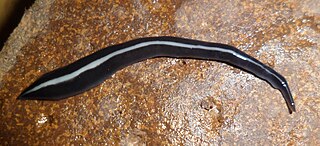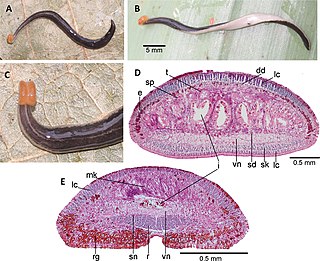
Geoplaninae is a subfamily of land planarians endemic to the Neotropical region. Members of this family are sometimes referred to as the Neotropical land planarians. However, one species, Obama nungara has been introduced in Europe.

Paraba is a genus of land planarians from South America.

Cratera is a genus of land planarians found in South America.

Paraba franciscana is a species of land planarian found in Brazil.
Cratera crioula is a species of land planarian belonging to the subfamily Geoplaninae. It is known from specimens found in Cantareira State Park, Brazil.
Cratera joia is a species of land planarian belonging to the subfamily Geoplaninae. It is known from specimens found in Serra do Mar State Park in Brazil.
Paraba caapora is a species of land planarian belonging to the subfamily Geoplaninae. It is found within Brazil.

Paraba multicolor is a species of land planarian belonging to the subfamily Geoplaninae. It is found within Brazil.

Choeradoplana albonigra is a species of land planarian belonging to the subfamily Geoplaninae. It is found in areas within the Atlantic Forest in Brazil, such as the Augusto Ruschi Biological Reserve, Desengano State Park, and the municipality of Teresópolis.

Geoplanini is a tribe of land planarians in the subfamily Geoplaninae.

Choeradoplana claudioi is a species of land planarian belonging to the subfamily Geoplaninae. It is known from specimens found in the Augusto Ruschi Biological Reserve in Brazil.

Choeradoplana onae is a species of land planarian belonging to the subfamily Geoplaninae. It is known from specimens found in the Augusto Ruschi Biological Reserve in Brazil.

Choeradoplana riutortae is a species of land planarian belonging to the subfamily Geoplaninae. It is known from specimens found in Serra dos Órgãos National Park in Brazil.
Cratera picuia is a species of land planarian belonging to the subfamily Geoplaninae. It is known from specimens found in Saint-Hilaire/Lange National Park in Brazil.
Cratera arucuia is a species of land planarian belonging to the subfamily Geoplaninae. It is known from specimens found in Intervales State Park in Brazil.
Obama apiguara is a species of land planarian belonging to the subfamily Geoplaninae. It is found within Brazil.
Paraba aurantia is a species of land planarian belonging to the subfamily Geoplaninae. It is found within Brazil.
Paraba iguassuensis is a species of land planarian belonging to the subfamily Geoplaninae. It is found within Brazil.
Paraba smaragdina is a species of land planarian belonging to the subfamily Geoplaninae. It is found within Brazil.
Piima is a genus of land planarians belonging to the subfamily Geoplaninae. It is monotypic, containing the sole species Piima ata. It is found in Brazil.








